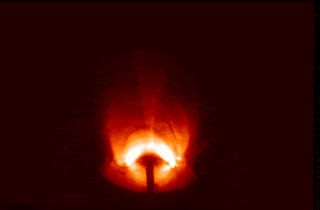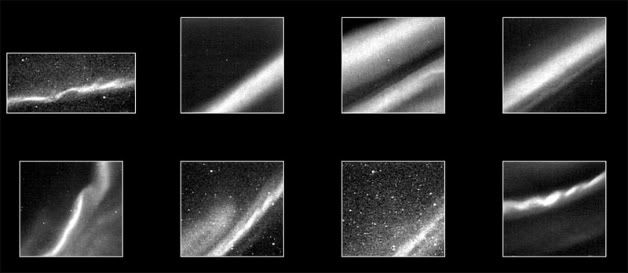SOLAR PROMINENCES
Prominences are huge clouds of gas which are often seen on or above the
solar limb, and are the easiest H-alpha emission feature to observe,
requiring a filter passband that can be one or two Angstroms wide.
Prominences observed on the solar disk are the darker features known as
Filaments, and need a passband width under one Angstrom in order to be
clearly visible. They often represent a sheared magnetic field boundary or
neutral line between opposite polarities where gas is trapped around bunched
field lines. The forms prominences can take vary widely, but the following
general scheme (Zirin) is somewhat useful in categorizing them:
CLASS 1: QUIESCENT FILAMENTS/PROMINENCES (long lived, fairly static)
a. QRF (Quiet Region Filament) ie: hedgerow, curtains, floating arches,
arcs, fans, ect.
b. ASCENDING PROMINENCES (end of the quiescent phase) "Disparition
Brusque" ("lifting off") eruption.
c. ARF (Active Region Filament): a filament in or near an active region
(netural line filaments).
CLASS 2: ACTIVE FILAMENTS/PROMINENCES (short-lived, moving)
a. LIMB FLARES (bright blobs, sometimes expanding into eruptive
prominences).
b. SURGES: collimated ejected material previously not seen (very sudden
jet of gas).
c. SPRAYS: uncollimated ejecta previously visible as pre-flare elevated
features (violent explosion).
d. FLARE LOOPS and CORONAL RAIN (often post-flare ejecta or other gas).

QUIESCENT PROMINENCES/FILAMENTS take a wide variety of forms, and tend to be
much longer than they are wide. Quiet Region Filaments (QRFs) are some of
the largest and longest lasting quiescents, with a few being visible for
several solar rotations. They are most often found where there is little
major activity such as the so-called "Polar Crown" high latitude areas,
although they may sometimes be found between or even near active regions.
The Hedgerow prominence is a fairly common QRF, and tends to look like an
irregular row of bushes. Hedgerows tend to be highly detailed, with
considerable branching and fine structure being visible at high resolution.
QRFs appear in many other forms, including floating arches, fans, curtains,
large curving blades, flames, and magnificent spiderweb-like arcs. Many have
upper edges that tend to be sharper than their lower sides, which can be
irregular or scalloped in form. Motion of material in QRFs is usually slow
and small in scale, leaving the overall prominence shape unchanged, but minor
changes can occasionally be seen in as little as 10 minutes. When viewed on
the solar disk, QRFs tend to lose some of their fine detail, becoming faint
irregular dark patches or large gently curving arcs of dark matter.
Prominences are darker on the disk because they absorb light from below and
then re-emit it in all directions. Some low-level filaments will often show
a brighter base due to a "blanketing" effect they have which reduces the
emission losses of the lower chromosphere.
Large Quiescents are not always stable, and if they exceed a height of
50,000 km above the surface (0.07 solar radii), they will usually break loose
from the sun within 48 hours in an eruption known as a "Disparition Brusque"
(sudden vanishing). Disparition Brusque eruptions usually last less than one
or two hours. They vary in form from a simple fading away of the quiescent,
to a spectacular "lifting off", where the prominence rises up and drifts away
from the sun, slowly breaking up in the process. Mild surface brightening
can also occasionally occur. Sometimes, a vanished quiescent will even
reform a few hours or days later near its previous location. In a few large
eruptions, a Dispartition Brusque can produce a Coronal Mass Ejection. Some
prominences do rotate slowly, and a few even look and act like tornadoes,
especially Disparition Brusque debris.
Active Region Filaments (ARF's) (best seen on the solar disk) tend to be
smaller, darker, and narrower than their giant cousins, the QRFs. They are
present in or near active regions and sometimes wind around or even through
large sunspot groups. The Neutral Line Filament in an active region under-
going the shearing of local magnetic fields is an example of an ARF. Arch
Filament System "filaments" between forming sunspots are really fibrils,
tending to be small and fairly short-lived unless flux emergence goes on for
very long. They can be particularly dark when a spot is emerging, and often
show Doppler shifts from material flowing in the fibrils.
ACTIVE FILAMENTS/PROMINENCES are short-lived features associated with
solar flares and other violent events. Limb Flares can appear on the solar
limb as elevated bright blobs. Occasionally, a small ARF in which a flare
begins will rise and expand into a majestic Eruptive Prominence, often in the
form of a twisting loop, while intense emission appears on the surface.
Flares sometimes produce a SURGE Prominence, visible near the limb as a well
defined jet of bright gas, and which can occasionally be seen in emission on
the solar disk.

These jets sometimes take the form of fine closely-spaced
spines which may be visible up to a solar radii from the limb. Surges can
also be seen as bright-based narrow dark features on the disk of the sun
(sometimes blue-shifted). Surges usually happen when a small satellite spot
of opposite magnetic polarity comes up in or very close to the penumbra of a
big regular sunspot. A small flare then occurs, resulting in an outward
ejection of gas which is confined into a narrow stream by the dominant spot's
field. The surge ejecta's velocity (50-200 km/sec) isn't enough to leave
the sun, and the gas will follow magnetic field lines as it falls or draws
back, sometimes creating a "splash" of brightening near the point of origin.
Much smaller non-flare surges can often be seen in active and occasionally in
Ephemeral regions on the solar disk as tiny blue-shifted "smoke stack" or
"puff" filaments, which resemble a smoke plume. Smoke stack surges usually
last only a few minutes, and can occasionally occur in the middle of a fairly
quiet area, especially in the early stages of an Emerging Flux Region.
Another active prominence type, usually resulting from the most violent
flares, is the SPRAY, a spectacular uncollimated expansion of disrupted ARF
material, sending debris flying off in many directions at speeds of 200-300
km/sec or more (up to 2000 km/sec for some of the largest flares). Often, the
filament involved becomes slightly elevated initially, then it explodes
outward in the spray. Motion of spray material can often be seen in only a
few minutes time, and occasionally, material can be seen leaving the sun
entirely (Coronal Mass Ejection).
Two other types of flare-associated active prominences are the Flare
Loops, and Coronal Rain. FLARE LOOPS are large thin circular or elliptical
vertical loops of gas which appear in the later stages or after a major
flare. They tend to be brighter at the top and at their bases, and often
show a nested structure of many very thin loops (Arcades), all with nearby
endpoints. These loops are where flare ejecta or other gas has encountered
the new magnetic field lines set up by the reconnection which occurs during
the flare. Motion of material can often be seen down both sides of the loop
towards the surface. The first loops form fairly low, while succeeding loops
form higher and higher above the surface. Flare loops are sometimes not seen
after some explosive flares or with small flares. They usually last only a
matter of hours, and should not be confused with the quiescent "Floating
Arches" prominences, which are thick or irregular in form, and are much
longer lived. CORONAL RAIN is the diffuse faint patchy emission from gas
descending back towards the surface as it encounters magnetic field lines.
It can often be seen often as material "raining" down into post-flare loops
or active regions.






